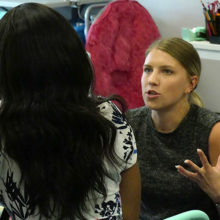'We have to get serious' about sufficient public funding for child care
Early Bird readers, hello again. Newcomers, welcome! If you were forwarded this email, you can sign up here to receive it every two weeks, and join our conversation on issues facing North Carolina’s young children and those who support them. If you’re already a subscriber, please help us reach more people by sharing this with your friends and co-workers interested in early childhood education.


As loyal Early Bird readers know, I hardly ever miss a Hunt Institute “Early Efforts” webinar. The episode last month on New Mexico’s work to redesign its child care subsidy program got me asking questions about North Carolina’s subsidized child care system.
The program, funded with a mix of state and federal dollars, helps families afford care. Last November, the program was serving more than 54,000 children across North Carolina. But the way the program works is leading to instability and inequity, researchers and advocates say.
That’s because the current model is based on what parents can afford, which isn’t enough to cover the full cost of high-quality care and learning. When I asked the state Department of Health and Human Services about its program, spokesperson Kelly Haight told me the department is looking to hire an outside consultant to come up with a better way to structure the program (like New Mexico, Louisiana, and Washington, D.C. have done).
This research could establish a structure that, if funded, would mean more stable programs for children and families, higher pay for teachers, and a more equitable funding across the state.
“We have to get serious about no longer just funding our prenatal-to-five programs, and our child care in particular, based on whatever’s available, but actually on what it costs to deliver the quality care,” said Elizabeth Groginsky, cabinet secretary of New Mexico’s early childhood education and care department, on the Hunt Institute webinar.
The federal Build Back Better legislation would have asked states to go through a similar process in order to base their programs on the true cost of care, including livable wages for early childhood teachers. It did not make its way to through Congress, though some early childhood components might reappear down the road. In President Joe Biden’s State of the Union address, he signaled that he hadn’t given up on those proposals: “Cut the cost of child care,” Biden said. “… Middle-class and working folks shouldn’t have to pay more than 7% of their income to care for their young children.
My plan would cut the cost in half for most families and help parents, including millions of women, who left the work force during the pandemic because they couldn’t afford child care, to be able to get back to work. Generating economic growth.”
As I mentioned in the last Early Bird, EdNC is traveling to local communities this spring. If you have contacts or story ideas in the following counties, let me know: Polk, Pender, New Hanover, Onslow, Chowan, Jones, Carteret, Craven, Pamlico, Beaufort, Hyde, Dare, Currituck, Camden, and Pasquotank.
Early Bird reads: What we’re writing
North Carolina researching how to remedy model for child care subsidies
“North Carolina’s Child Care Subsidy program is another tool to support high quality, accessible child care that keeps our economy moving,” said Kelly Haight, a DHHS spokesperson, in an email.
“Subsidy rates that are tied to tuition and market rates often understate the true cost of providing high quality child care, especially for infants and toddlers. Studying alternative models for subsidy rates will help us understand if new calculation methods could better reward quality child care, promote stability in programs across the state and ensure access for families.”
Your take, for goodness sake: EdNC perspectives
Perspective | Overlooked diaper need for North Carolina families
Lindsay Saunders, communications director for the NC Early Childhood Foundation, spoke with diaper banks who have experienced an overwhelming increase in demand from families across the state.
Since the start of the pandemic, “We have seen a 400% increase in diaper requests, an 800% increase in period products and a 2000% increase in adult incontinence supplies,” said Michelle Old, executive director of the Diaper Bank of North Carolina. “It is unsustainable and overwhelming. It has not slowed down at all.”
“Covering the cost can be around 14-16% of a family’s income when they’re living in poverty,” Saunders reports.
“Between the increased cost of living, limited employment opportunities, expensive retail cost of diapers, and significant poverty, parents are strained when trying to make ends meet and ensure they have everything for their children.”
Meagan Leimena, co-executive director of Babies Need Bottoms, said, “We have to see diaper need recognized in how it sits at the intersection of so many social needs. It affects everyone, everywhere.”
In other early learning news: What I’m reading
How the pandemic is affecting babies’ brains - From The Hechinger Report
Inside Colorado’s kindergarten enrollment rebound: Simple numbers, complicated stories - From Chalkbeat
The Child Care Crisis: Innovations To The Rescue. - From Forbes
Is your tot on track? Markers for early childhood milestones get an update - From The San Diego Union-Tribune
A historic child care investment saved centers from collapse. What happens when the money runs out? - From The 19th News
Buncombe floats $7.5 million pre-K expansion - From Mountain Xpress
Research & Resources: Let's talk new COVID guidance
The state’s March COVID guidance includes big changes for early childhood programs. Masks are no longer recommended for children, teachers, or staff members. Masks are not required for drivers of buses or vans operated by early learning programs.
Formal contact tracing is also no longer recommended in child care settings by the Department of Health and Human Services. Explanations for these changes on page 3 of the toolkit say that contact tracing is ineffective at this stage of the pandemic due newer variants’ shorter incubation period, milder symptoms, and lack of test results during the most contagious period of infection.
The Division of Child Development & Early Education and the Division of Child and Family Well-Being are hosting a virtual discussion on the latest guidance on Thursday, March 17 from 12-1 pm. You can attend virtually or call into the event at (312) 626.6799.
The department continues to recommend the promotion of vaccination and boosters for children and staff. A vaccine option has still not been approved for children under five years old.
ProPublica reported on reasons for the hold-up last week: “The agency has a challenging job of balancing the need for thoroughness with speed, said Dr. Paul Spearman, director of the division of infectious diseases at Cincinnati Children’s Hospital Medical Center. Children are not just little adults — their immune systems are different — so you can’t just scale down the existing vaccine proportionally and presume it’ll be both safe and effective. It’s not unusual for children’s vaccine trials to take longer than adults’ because of additional steps needed to find the correct dosage for different age groups, Spearman said. ‘There’s more care taken about safety and finding a precise dose, and more scrutiny, because it’s a vulnerable population.'”


